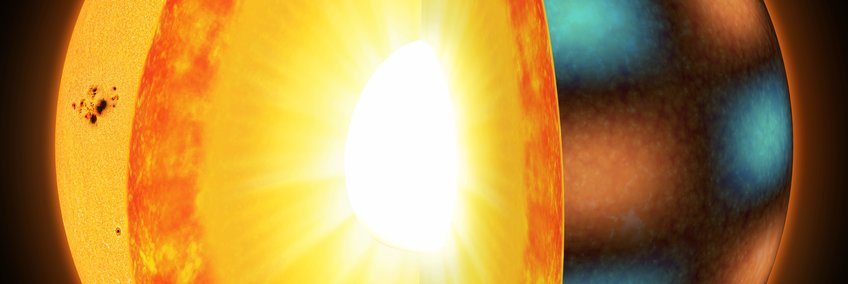
Research Topics
Sun
Major Projects: Solar Dynamics Observatory, WholeSun ERC Synergy project, German Data Center for SDO, Solar Orbiter, collaboration with Max Planck Fellow Group Inverse Problems, SFB Mathematics of Experiments, PMI for for ESA’s Vigil mission.
Helioseismology, the use of solar oscillations to measure physical conditions in the solar interior, includes a wide range of methods. Global helioseismology is based on measuring and interpreting the resonant frequencies of the global acoustic oscillations of the Sun and allows us to study axisymmetric properties of the Sun such as internal differential rotation. Local helioseismology involves measuring the correlations of the surface wave field, as well as properties of resonant modes within small patches of the Sun, and allows three−dimensional probing of the solar interior, as well as access to additional flow components such as the north−south meridional flow. In the department, we develop and apply both global and local methods of helioseismology; this involves solving the forward and inverse problems with the help of applied mathematicians. This work benefits from an active collaboration with the Fellow Group of Thorsten Hohage and with the Makutu team at Inria Bordeaux Sud-Ouest (e.g. with Florian Faucher who just won an ERC Starting Grant to work on helioseismic inversions).
Helioseismology inferences are combined with physical and numerical models of the solar interior to better understand the global dynamics of the solar convection zone and the solar dynamo. Current efforts include the development of models of solar magnetoconvection in spherical shells and flux-transport models of the solar cycle.
Stars and Planetary Systems
Major Projects: CoRoT, Kepler, TESS, PLATO
We study stellar rotation and activity using asteroseismology and photometric variability. Measurements of rotation and differential rotation, in combination with observations of stellar activity, provide strong constraints on dynamo models. Unfortunately, the internal differential rotation of any single Sun-like star is often poorly constrained by observations. The full sample of Kepler stars (later PLATO) which includes evolved and multiple stars is, however, very promising for extracting general patterns in rotation-activity-age relationships. Achieving this will require ever more reliable and accurate stellar evolution models with improved physics. We also study ways to improve the detection and characterization of exoplanets using photometric light curves. The parameters of planet-host stars, including their age, are inferred by combining asteroseismology and stellar models.
Ongoing Space Missions and Projects
Major space misison projects: PLATO, WholeSun
The PLATO Data Center project supports ESA’s PLATO mission. It is designed to detect exoplanets and unravel the internal structure of stars by capturing their subtle brightness variations. The WholeSun project unifies solar interior, surface, and atmospheric modeling into a global simulation effort—offering unprecedented insight into the workings of solar and stellar dynamos.
Helioseismology and Asteroseismology tools
Helioseismic observations from the SOHO spacecraft (a very successful collaboration between ESA and NASA) since 1996 and the ground-based network GONG, helioseismology has already provided some important results, revealing regions of rotational shear in the Sun’s interior, solar-cycle variations in the rotation rate, and mysterious quasi-periodic changes at the base of the convection zone.
PhD Projects
We offer the opportunity to students to engage in research on Helioseismology and asteroseismology. The department frequently offers PhD projects.



